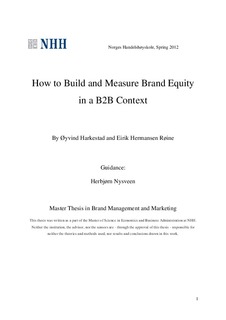How to build and measure brand equity in a B2B context
Abstract
Little research has been conducted on Business to business (B2B) marketing compared to the significant amount of research conducted on Business to consumer (B2C) marketing. This master’s thesis is intended to aid B2B companies build and measure their level of brand equity. Consequently, we have created a theoretical framework, seeking to fulfill this purpose.
The main model we present is mainly based on Keller’s (2008) The Customer Based Brand Equity Model, adjusting and developing it to fit the needs of a B2B company. The modifications and further work we have made throughout this process are also based on other theoretical articles, books, newspapers and lectures. Thus, some of the alterations are made on our interpretation of translatability.
In addition to a modified version of Keller’s CBBE model, our framework consists of a methodological tool schema, based on the drivers of our adjusted model. The methodological tool schema’s intention is to help reveal the differences between the desired and actual perception of a company, and identify measures that can be taken into action in order to minimize the deviation. We suggest that this should be done by interviewing both internal and external resources on matters concerning the drivers identified in our modified model. The schema also gives an overview of the respondents’ answers, and helps systemizing it. To assist the interviewers using the schema, we have created an interview guide, containing all information and questions that should be presented and asked to the interviewees.
We have partly used Vimond, a startup company providing the technology for internet streaming services, as an illustration for a company in the introduction phase to demonstrate how the model is intended to work. Still, the framework should help any B2B company build brand equity in a purposeful way.
